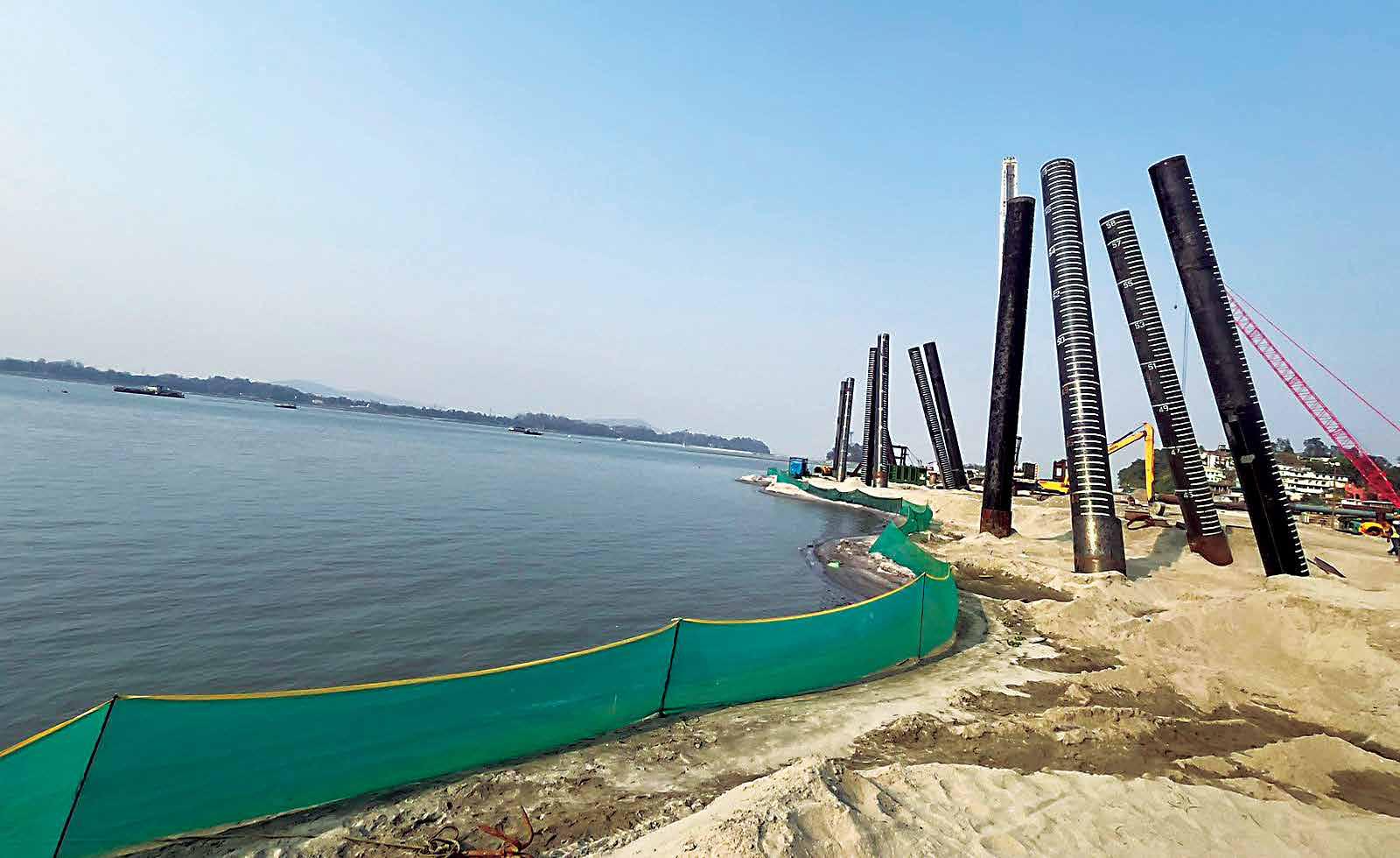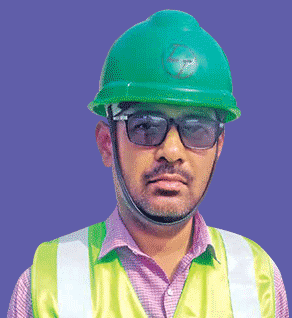Protecting the ecology and bio-diversity of the Brahmaputra

River Brahmaputra. 3,969 km, flows through Tibet, India, and Bangladesh, 9th largest river in the world by discharge, 15th longest and recognized as a National Waterway #2 by the Government of India in 1988. Responsible for developing, maintaining, and regulating Inland Waterway Transport (IWT) services in the State, the Directorate of Inland Waterway Transport, Assam, intends to develop ferry terminals at the Guwahati Gateway Ghat (GGG) in Guwahati.
L&T GeoStructure has been mandated to Plan, Design, Engineer, Procure, Build and Commission a passenger ferry terminal at GGG on the Brahmaputra as per Indian and relevant international standards to ensure safe berthing of vessels and safe boarding of passengers, sequential boarding of bikes and 3‑wheeled vehicles carrying passengers on the ferry throughout the year at all water levels.
![]()
We took two weeks in October 2023 to ecologically monitor the river from about 1 km upstream to 1 km downstream from the centre of our project, enlisting the support of an agency, Mitra Sk, and a senior biodiversity specialist, Dr Bhaskar Mitra, from their ranks, to help and guide us in our endeavours.
Samir Sarkar
Project Manager
![]()

Maintaining the pristine ecology of the river
One of the primary considerations for Project Manager Samir Sarkar, Project EHS Head Pallab Mukhopadhyay, and team at this World Bank funded project was how to ensure that the ecological balance of the river was maintained in the face of their construction activities.
![]()
By proactively addressing environmental risks associated with construction activities, we have reduced the potential for regulatory fines, legal liabilities, and project delays, thereby safeguarding the Company’s reputation and financial interests.
Pallab Mukhopadhyay
Project EHS Head
![]()

Ecosystems are dynamic, with long-term, seasonal changes in the flora and fauna that requires ecological monitoring, the first step for which is research to determine the reasons of observable patterns, and for taking systematic, repeated measurements of environmental conditions, using the same methods in the same places over time to make long-term comparisons. “Changes in the health of an ecosystem is attributable to a variety of causes,” explains Pallab, “including invasive species, urbanization, climate change, and extreme weather events like drought and flooding.” Ecosystems can be easily stressed by human activities, climate change, sediments, nutrients, contaminants, and several other variables.
“We took two weeks in October 2023 to ecologically monitor the river from about 1 km upstream to 1 km downstream from the centre of our project,” informs Samir, “enlisting the support of an agency, Mitra Sk, and a senior biodiversity specialist,
Dr Bhaskar Mitra, from their ranks, to help and guide us in our endeavours.” In addition, a team of qualified biologists has been deployed to monitor changes round the clock in the biodiversity and provide real-time information to construction managers to implement the necessary measures.
The entire ecosystem was researched including the flora, planktons, birds, fishes, mammals, monkeys, rats & rodents, bats, dolphins, trees, and the soil, after which the team evolved a set of protective measures to maintain the ecological balance and biodiversity of the river.
Silt screens & geo-textile sheets have been deployed to contain the movement of the sediments and prevent waste from entering the river, to preserve the quality of the water and aquatic habitats.
Bubble curtains have been installed around the construction zone to mitigate underwater noise pollution, protect the river dolphins and preserve other aquatic biodiversity.

Deterrent devices are used, supervised by dolphin observers, to deter the movement of the dolphins in the construction zone. Hydrophones accurately track and monitor the presence of dolphins during the night.
Continuous monitoring: The team has engaged third-party agencies to regularly monitor the Terrestrial and Aquatic ecology prey base, and underwater noise levels to assess the impact of construction activities and modify the safety measures, as needed.
A rescue team on call: A specialized team comprising personnel from the relevant government departments and veterinarians has been assembled to respond to any incidents involving injured species.
Use of less noise generating equipment: During the construction phase, the team decided to deploy advanced equipment to minimize noise levels. Despite these measures, if some noise did occur above permissible levels especially during piling activities, people were requested to share their concerns for immediate addressing. “Our piling activities were carried out at 44 locations in the project site for holding the floating pontoon and gangway as a part of our design,” points out Pallab. For this purpose, the Jackup barge with the piling-rig was placed in the river, and after the initial piling, the water level was reduced so that the piling activity could be completed on land. Junttan hammers with noise reduction equipment were used during the piling activity.
Awareness & training: Construction managers and workers were educated about protecting the river’s ecology and maintaining safety during operations.
Samir, Pallab, and team are delighted that their efforts to prioritize environmental conservation and minimize disruption to local ecosystems, have reinforced L&T’s commitment to sustainability, enhancing the Company’s reputation as a responsible corporate citizen. “By proactively addressing environmental risks associated with construction activities, we have reduced the potential for regulatory fines, legal liabilities, and project delays, thereby safeguarding the Company’s reputation and financial interests,” smiles Pallab. Their demonstration of a proactive approach to environmental protection is bound to stand the team in good stead with their stakeholders, including government agencies, local communities, and environmental advocacy groups, thereby enhancing trust and collaboration.
![]()
Investing in innovative solutions to minimize the environmental impact contributes to the long-term viability of the project and LTGS’s operations ensuring continued success and profitability in the face of evolving regulatory standards and societal expectations.
R V Sudhakar
Head – EHS, L&T GeoStructure
![]()


Plankton collection and sampling from river water
“Investing in innovative solutions to minimize the environmental impact contributes to the long-term viability of the project and LTGS’s operations,” remarks R V Sudhakar, Head – EHS, L&T GeoStructure, “ensuring continued success and profitability in the face of evolving regulatory standards and societal expectations.”
“Overall, integrating environmental considerations into the business strategy not only mitigates risks but also creates opportunities for competitive differentiation, resilience, and sustainable growth,” sums up Samir.
Amidst the hum of progress, a vigilant effort has been unfolding to safeguard the ecosystem and although the project is into its finishing stages, the team remains focused on their sustainability goal.